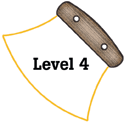
Alaska Science
Key Element A9
 |
Alaska Science |
|
Performance Standard Level 4, Ages 15–18
|
|
|
|
Sample Assessment Ideas
|
Standards Cross-References
|
||
|
National Science Education Standards Plant cells contain chloroplasts, the site of photosynthesis. Plants and many microorganisms use solar energy to combine molecules of carbon dioxide and water into complex, energy rich organic compounds and release oxygen to the environment. This process of photosynthesis provides a vital connection between the sun and the energy needs of living systems. (Page 184) The atoms and molecules on Earth cycle among the living and non-living components of the biosphere. (Page 186) Energy flows through ecosystems in one direction, from photosynthetic organisms to herbivores to carnivores and decomposers. (Page 186) All matter tends toward more disorganized states. Living systems require a continuous input of energy to maintain their chemical and physical organizations. With death, and the cessation of energy input, living systems rapidly disintegrate. (Page 186) The energy for life primarily derives from the sun. Plants capture energy by absorbing light and using it to form strong (covalent) chemical bonds between the atoms of carbon-containing (organic) molecules. These molecules can be used to assemble larger molecules with biological activity (including proteins, DNA, sugars, and fats). In addition, the energy stored in bonds between the atoms (chemical energy) can be used as sources of energy for life processes. (Page 186) The chemical bonds of food molecules contain energy. Energy is released when the bonds of food molecules are broken and new compounds with lower energy bonds are formed. Cells usually store this energy temporarily in phosphate bonds of a small high-energy compound called ATP. (Page 186) The distribution and abundance of organisms and populations in ecosystems are limited by the availability of matter and energy, and by the ability of the ecosystem to recycle materials. (Page 186) As matter and energy flows through different levels of organization of living systems–cells, organs, organisms, communities-and between living systems and the physical environment, chemical elements are recombined in different ways. Each recombination results in storage and dissipation of energy into the environment as heat. Matter and energy are conserved in each change. (Page 186) |
Benchmarks At times, environmental conditions are such that plants and marine organisms grow faster than decomposers can recycle them back to the environment. Layers of energy-rich organic material have been gradually turned into great coal beds and oil pools by the pressure of the overlying earth. By burning these fossil fuels, people are passing most of the stored energy back into the environment as heat and releasing large amounts of carbon dioxide. (Page 121) The amount of life any environment can support is limited by the available energy, water, oxygen, and minerals, and by the ability of ecosystems to recycle the residue of dead organic materials. Human activities and technology can change the flow and reduce the fertility of the land. (Page 121) The chemical elements that make up the molecules of living things pass through food webs and are combined and recombined in different ways. At each link in a food web, some energy is stored in newly made structures but much is dissipated into the environment as heat. Continual input of energy from sunlight keeps the process going. (Page 121) |
|
Table of Contents | Return to Alaska Native Knowledge Network